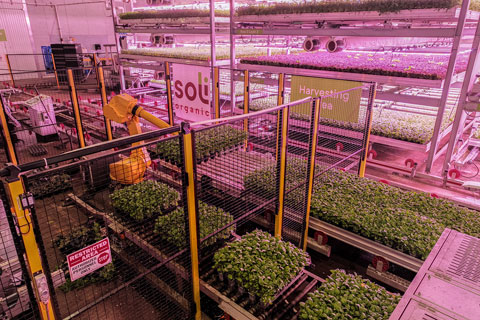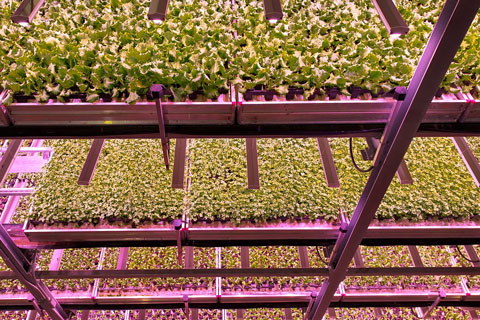5/1/2023
From Farm to Vertical
Jennifer Polanz
Soli Organic has one of the most unique stories I’ve heard yet in the CEA space.
The company, formerly Shenandoah Growers, is one of the leading producers of organic culinary herbs in the United States and started out growing in fields. They moved some production in to greenhouses and began growing living herbs in pots, as well as cut herbs. Those greenhouses are in Harrisonburg, Virginia; Bowersville, Georgia; Indianapolis, Indiana; Duvall, Washington; and Rice, Texas.
Then the company began R&D on indoor multi-level production, starting with a facility in Harrisonburg, then a much larger one in Elkwood, Virginia. But the real plan and the future model? It’s what Soli CEO Matt Ryan calls the giga-sized location of 100,000-plus sq. ft. in Anderson, South Carolina, that spans six levels of growing space.
 Pictured: Automation inspired by the floriculture industry helps move trays of crops from growing through harvesting.
Pictured: Automation inspired by the floriculture industry helps move trays of crops from growing through harvesting.
There are two more large-scale facilities under construction in Marysville, Washington, and Brooks, Texas, both with attached packhouses. Greenhouses will stay in the mix for now to grow the living herb products, but the multi-level indoor facilities will be used to grow cut herbs, leafy greens and a new crop, spinach. What’s also unique is it’s not hydroponic—they grow in soil in the vertical farms, hence the new name Soli, the Latin word for soil.
Here’s Soli’s plan, in Matt’s words (edited for space).
Jen Polanz: What are the main goals for Soli over the next five years or so?
Matt Ryan: I would start with the No. 1 goal is to be the most cost-efficient grower of quality organic produce on planet Earth.
JP: That’s a big, big statement.
MR: You bet it is and we’re doing it.
JP: Tell me about that—how are you able to do that, and are you doing it right now or is that what you’re working toward?
MR: Right now. In fact, the reason why we’re able to get the funding we’re doing and the interest that’s coming our way, and frankly the distribution that’s growing, is because we are doing it.
Let me give you an example: I think I mentioned this when I talked [at Indoor Ag-Con], the 2-oz. basil you see in the Northeast, which prices out on shelves at $3.49 to $3.99 depending on the retailer, is coming out of our Elkwood facility. Our Elkwood facility is one of these large-scale facilities I just mentioned to you. It’s great quality organic basil, and it is growing in our Elkwood facility and we’re getting a margin on that product that makes us profitable at Elkwood. So we are actually delivering a lower price point for organic. Now keep in mind all the CEA players out there are basically charging the same amount for their produce in the Northeast, for their basil, and they’re only putting a 1.25-oz. package out.
 Pictured: You can see the layers of production space here. The newest facilities will have six layers on a 100,000-plus sq. ft. footprint.
Pictured: You can see the layers of production space here. The newest facilities will have six layers on a 100,000-plus sq. ft. footprint.
JP: We don’t often see producers moving from greenhouse to indoor farms. What financial benefits do you see going vertical over greenhouse?
MR: It’s cheaper to grow indoors than it is in greenhouses and we proved that through the track record of our own operations in Harrisonburg. We went to this multi-level facility in Harrisonburg in 2019, we had results. What that showed is we could grow more cost-effectively there than in greenhouses and the reasons why are very interesting.
Number one, yeah, you have to pay for lights. Yes, that is a cost. That is the downside if you put apart the cost of building the facilities themselves. However, what you don’t have in those facilities is the gobs of people, labor costs, that you see in greenhouses. We estimate it is one-tenth the labor cost. In addition to that, when you grow indoors, control of the lighting and the variation you get on lighting from greenhouse means that you get far less yield—consistent yield, which is really important in our business—than you do in an indoor facility.
JP: What are some of the production challenges you’ve had to overcome with vertical farming in making that transition from greenhouse to vertical farm?
MR: Obviously we had to figure out in these multi-levels how to move product around with automation. One of our big step-ups was to go from our smaller facilities in Harrisonburg that didn’t have as much automation as we do in our large-scale facilities in Elkwood and now Anderson, where you’re literally moving flats of pots of plants around. So we borrowed heavily, as I disclosed, from the floriculture industry to do that. Installing all this automation there was, frankly, a little bit of “Will this work?” because we hadn’t done it before and the answer is “Absolutely, yes, it has” because now we’re doing it.
One of the issues, of course, is carbon dioxide, and the dirty secret as you know of the floriculture and the greenhouse industries is people tend to burn propane, for lots of reasons, including the carbon dioxide it gives off. What we have done—and it hasn’t gotten a lot of attention yet, surprisingly—we are now in our multi-level facilities taking the carbon dioxide offput from breweries and distilleries. Stuff that would normally get released into the atmosphere and releasing it inside our facilities. And that’s been a big deal and a big challenge and I’m really proud of where we are. That’s a huge advantage, and ultimately, it will put us on a path—and we’re not there yet—but will put us on a pathway to carbon neutrality.
JP: Where do you see CEA, in general, going over the next five years?
MR: I would say we are in the very early days. This is an industry that’s going to be here for a long time to come. And I liken it to the electric car industry … there were a lot of early attempts at electric cars that were interesting and groundbreaking, but ultimately not commercially viable. I think we are going to see the emergence of commercially viable indoor growing, CEA growing, across the next year or two. And, ultimately, that will mean consolidation. I’m optimistic, of course I am, about Soli because I know our financials, and there may be others out there who do the same. But it is going to be the people who can grow cost effectively and meet the market for what the market wants that are really going to win.